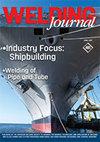热丝气体金属电弧焊中的金属传递机制
IF 1.4
3区 材料科学
Q2 METALLURGY & METALLURGICAL ENGINEERING
引用次数: 2
摘要
热丝气体金属弧焊(HW-GMAW)工艺被广泛应用于通过焦耳加热来提高二次丝的熔化速度,而不会显著增加基材的总热量输入。由于对相关电弧动力学及其对焊头几何形状的影响的了解有限,本研究采用三次重复的双因素全因子实验,考虑了这些是如何受到热线极性(负极性或正极性)、热线进给速率和热线取向的影响的。在焊接过程中,高速成像与电流和电压采集同步,研究电弧动态。在此之后,每个复制焊缝被切割成三个横截面,这是由标准金相检查。初步结果表明,电弧在研究的工艺参数范围内是稳定的。电弧极性对电弧相对于热丝的位置有影响,当电弧被热丝吸引时,穿透深度下降。本文章由计算机程序翻译,如有差异,请以英文原文为准。
Metal Transfer Mechanisms in Hot-Wire Gas Metal Arc Welding
The hot-wire gas metal arc welding (HW-GMAW) process is widely used to increase the melting rate of a secondary wire through Joule heating without significantly increasing the total heat input to the substrate. Because there is limited knowledge regarding the associated arc dynamics and its influence on bead geometry, the present study considers how these are affected by the hot-wire polarity (negative or positive), hot-wire feed rate, and hot-wire orientation using a two-factor full factorial experiment with three replicates. During welding, high-speed imaging synchronized with current and voltage acquisition to study the arc dynamics. After this, each replicated weld was cut into three cross sections, which were examined by standard metallography. The preliminary results suggest that the arc was stable within the range of process parameters studied. The arc polarity played a role on arc position relative to the hot wire, with a decrease in penetration depth observed when the arc was attracted to the hot wire.
求助全文
通过发布文献求助,成功后即可免费获取论文全文。
去求助
来源期刊

Welding Journal
工程技术-冶金工程
CiteScore
3.00
自引率
0.00%
发文量
23
审稿时长
3 months
期刊介绍:
The Welding Journal has been published continually since 1922 — an unmatched link to all issues and advancements concerning metal fabrication and construction.
Each month the Welding Journal delivers news of the welding and metal fabricating industry. Stay informed on the latest products, trends, technology and events via in-depth articles, full-color photos and illustrations, and timely, cost-saving advice. Also featured are articles and supplements on related activities, such as testing and inspection, maintenance and repair, design, training, personal safety, and brazing and soldering.
 求助内容:
求助内容: 应助结果提醒方式:
应助结果提醒方式:


